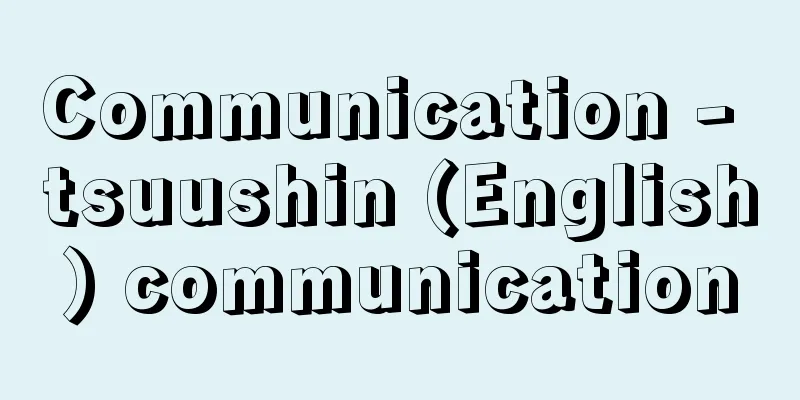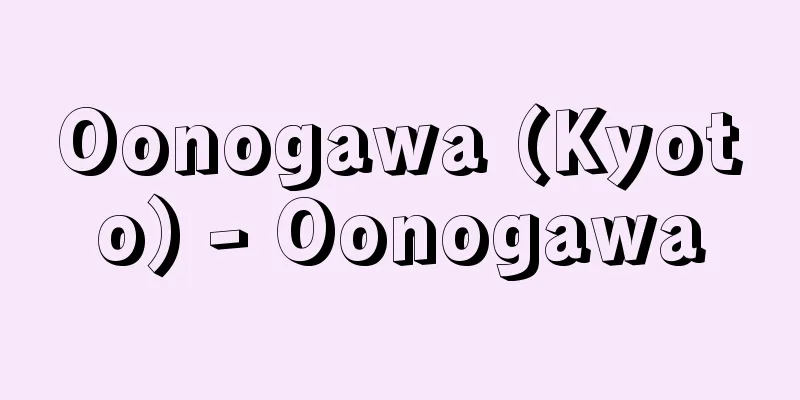Communication - tsuushin (English) communication

|
It is an intellectual activity that uses some kind of tool or medium to exchange will, information, emotions, etc., going beyond the distance limitations of direct communication using the natural human abilities of vocalization, hearing, and vision to recognize gestures, etc. In the modern age, communication methods have developed remarkably, to the point where social life would be impossible without the use of communication, as typified by telephone, radio, television, computer, and mobile phone. [Iwao Ishijima] historyHistory leading to telecommunicationsThe development of communication technology can be seen as an extension of the various ways that humans have devised and invented to compensate for deficiencies in vision and hearing since the time before they had written language. It is said that in the 13th century BC, Greek troops reported victory to their homeland by relaying fire during the Greek-Trojan wars. The Persian ruler Kyros II (reigned 559-529 BC) built a series of towers radiating from his capital, on which soldiers shouted messages one after another. Legend has it that Alexander the Great used a giant megaphone on a similar tower to make his soldiers' voices carry 12 miles away. The Ashanti people of Ghana are said to still be able to communicate using a special drum passed down from their ancestors more than 2,000 years ago. The signal fire used by Native Americans in the American West is well known, but it has also been used worldwide since prehistoric times. After the invention of writing, communication began to take the form of letters, and methods of transmission such as couriers and express horses appeared. Letters are superior to previous means of communication in terms of the accuracy of their delivery and the volume of messages they can send, but they are considerably inferior in terms of the time it takes to deliver them. Carrier pigeons were used to shorten the time, but it cannot be denied that they have a low degree of reliability in delivery. With the invention of the telescope, the freedom to develop communication methods increased, and in 1793, C. Chappe of France installed communication towers called semaphores at intervals of about 10 kilometers along the 230 kilometers between Paris and Lille. Large arms that could change shape were installed on top of the towers, and the changes in shape were observed and read by a telescope, and the messages were relayed one after another. The changes in the arms corresponded to 192 types of codes, and it is said that they conveyed complex meanings. With this system, the good news that the French army had recaptured Roquenoy was brought on August 15, 1794, during the French Revolution, and then two weeks later, news was received that Condé had been occupied. This event made the French Revolutionary government realize the importance of the system, and a communication network of semaphores was spread throughout the country. By 1795, France was covered by a network of 556 semaphores with a total length of 4,800 kilometers. However, the rising costs of building one large communications tower after another put the economy under strain. Only military necessity promoted the construction, and only the profits from the lottery ticket prevented it from being abandoned. Shap died in 1805, but the tension and anxiety in his later years are said to have been unbearable. In America, the first visual communication system based on the semaphore principle was built by Jonathan Grout (1737-1807) in 1800. It was used to send news to merchant ships on the transmission route between Boston and Martha's Vineyard, about 104 km south of Boston. At that time, no one doubted that visual communication was the fastest means of communication. Semaholes were also used in the UK, and a historical document from that time states: "A single character signal was sent from London to Plymouth and returned within three minutes. The communication path was at least 500 miles long. For this experiment, the person in charge of each post (communication tower) was instructed to set up a system in which the signal would be retransmitted as soon as it was received. The transmission speed was 170 miles per minute, or an astonishing 3 miles per second, or 3 seconds per post. However, this system was extremely expensive to build, was a waste of manpower, and was not available to the general public. Even more problematic was that it had to be stopped at night and in bad weather. The station at Putney Heath, which communicated with Chelsea in London, was often rendered useless by the London smoke that filled the Thames Valley when the wind blew easterly." In the world of communication, electricity replaced visual signals such as the semaphore. The history of electric communication is generally considered to begin on February 17, 1753, prior to the invention of the semaphore. On that day, a research paper signed "CM" was published in Scots Magazine . Not much is known about the "CM" who signed it, but in the paper he proposed the following: "A set of electric wires, equal in number to the number of letters of the alphabet, should be stretched horizontally between two given places. These should be parallel to each other, and each should be spaced one inch from the next. At the receiving end, a small ball should be suspended over every wire, and small pieces of paper with the alphabet written on them should be placed one-sixth or one-eighth of an inch below every ball." As early as 1787, the Spaniard Agustin de Betancourt (1758-1824) conducted experiments to send telegraph messages between Madrid and Aranjuez, and in 1798 Don Francisco Salva (1751-1828) of Barcelona successfully connected Madrid and Aranjuez over the 42 kilometres with a single electric cable. Then, in 1816, British telecommunications engineer F. Ronalds conducted various experiments in the garden of his vast house in Hammersmith, a suburb of London, and finally invented a new system. This involved installing a rotary dial with the alphabet written on it at both the sending and receiving ends, which rotated synchronously (the method is unknown), keeping the transmission line constantly charged, but discharging it when the desired letter came into view at the sending end. A small ball made of wood pith called a pith ball was attached to the receiving end, and when it bounced the letter that was seen indicated the letter that had been sent. This system was adopted by the British Admiralty, and it was said that "no telegraph could be better than the device now being adopted, and all others would be unnecessary." In 1800, the Italians A. Volta and L. Galvani invented a new kind of electricity, the battery. It was a low-voltage, practical, and easy-to-handle electricity (battery) rather than the high-voltage, elusive static electricity. Later, in 1804, Salva of Barcelona proposed an ingenious new type of telegraph. When an electric current was passed through electrodes submerged in water, electrolysis occurred and hydrogen bubbles rose to the cathode, which could be used as an indicator for communication. However, this invention also did not come into widespread use at the time. In the summer of 1809, S. T. Semmering wrote about electrochemical communication in the journal of the Munich Academy of Science . One of his friends, Russian diplomat Baron Schilling (1780-1837), was inspired by Semmering's experiments and devoted himself to perfecting the electromagnetic telegraph. In 1832, Schilling used the tendency of a compass needle to deflect due to the current flowing around it as an indicator for the receiver. This phenomenon had been first observed by H. C. Oersted, a professor of physics at the University of Copenhagen, whose work was published in Latin in 1820. Schilling was able to use the principle of this deflection (galvanometer) as an indicator for the receiver. In 1837, Tsar Nicholas I appointed Schilling to the commission for the construction of a telegraph system between St. Petersburg and Peterhof Palace, but unfortunately he died the same year. In 1833, Professors K.F. Gauss and W.E. Weber of the University of Göttingen put the first electromagnetic galvanometer telegraph device into practical use, transmitting scientific information over a distance of 1 kilometer between the university's physics laboratory and astronomical observatory until 1838. The principle of telegraphy with four basic signal units developed by Gauss and Weber is similar to the Navy Galvanometer developed by W. Thomson (Kelvin) of England in 1858 as a terminal device for long-distance undersea cables. In March 1836, a copy of Schilling's plans was inspected by a young Englishman named W. F. Cook. In April 1837, Cook created various types of telegraph equipment. He wanted to install one of them on the Liverpool-Manchester railway, but encountered many difficulties and asked for help from C. Wheatstone, a professor of natural sciences at King's College, London. Together they obtained a patent for a five-needle electromagnetic telegraph in 1837. The two were then appointed consultants for the construction of a telegraph system on the Great Western Railway between Paddington and West Drayton, a 21-km stretch. This model used two needles and required a pre-agreed code to send messages. In 1839, the line was extended to Slough. Then, on January 1, 1845, a telegram was received at Paddington Station. The telegram reported that a murder had been committed and that the suspect had boarded the 7:42 train to Paddington, sitting in the rear compartment of the second first class carriage. A policeman was waiting at Paddington Station and arrested the culprit. The culprit (John Tawell) was later hanged, but the incident became the talk of London. It showed people the power of the telegraph, which was faster than the great high-speed railways. In 1846, Cook and Wheatstone founded a telegraph company, and by 1852, it is believed that about 6,500 kilometers of telegraph lines had been installed in the UK. Queen Victoria knighted them, and William Cook and Charles Wheatstone were remembered as great pioneers of telecommunications. At the time, it was believed that no longer long-distance communication system would be invented. [Iwao Ishijima] Telegraph and telephoneThe Semahall and other communication systems mentioned above came to an end with the practical application of the Morse telegraph, invented by American S. F. B. Morse with the help of Alfred Lewis Vail (1807-1859). On May 24, 1844, Morse conducted a communication experiment between Washington, DC and Baltimore, transmitting the famous message "What hath God wrought," ushering in the era of full-scale telegraphy. By the end of the Civil War in 1865, the Union Army had laid out a telegraph network of 24,000 kilometers and carried 6.5 million military communications. This clearly showed the defeat of the Confederate Army, which did not have this means. In July 1866, the Atlantic cable connected America with the European continent, making it possible to communicate between New York and London within seconds. On the other hand, immediately after Morse invented the telegraph, scientists began to wonder whether it was possible to transmit the human voice over electric wires. The answer to this problem was given by A. G. Bell of the United States on February 14, 1876, when he applied for a patent for a device called a telephone (an electromagnetic transmitter and receiver). At that time, the Western Union Telegraph Company was operating a telegraph business in the United States, and the Bell Telephone Company entered the communications business later. The two companies operated both telegraph and telephone businesses, and as a result of the fierce competition, Bell was driven to the brink of bankruptcy. In 1879, as a means of breaking out of the financial difficulties, Bell made an agreement to leave the telegraph business, which was more profitable at the time, to Western Union and concentrate on the telephone business, which was less profitable. It took until the 1890s for Bell's telephone business to overcome its difficulties and begin to develop, but after that, AT&T, the successor to the Bell Telephone Company, took control of Western Union, teaching us that communications businesses cannot develop unless they constantly pursue new technologies and improve public convenience. [Iwao Ishijima] Wireless CommunicationIn 1896, Italian G. Marconi invented wireless telegraphy and successfully transmitted radio waves across the Bristol Channel for 14 kilometers, and in 1899 he successfully transmitted radio waves across the English Channel. At the same time, in 1898, during the Spanish-American War, the Spanish fleet led by Admiral Cervilla was trapped in Santiago and annihilated by the American fleet. The reason for this was that the Spanish fleet did not receive instructions from the US. The telegram sent from the US to the Spanish fleet was supposed to pass through Britain, reach America by undersea cable, and then be sent to Cuba for delivery to the fleet. However, this telegram was easily intercepted by the enemy country, America, and the Spanish fleet, waiting for instructions, was annihilated in the confusion. This incident was a big shock to the Western powers, making them realize the importance of communication policy. It strengthened the position of the UK, which controlled the undersea cables, and at the same time, it inevitably increased interest in wireless communication, which seemed to be a cheaper method of communication. The situation was similar in Japan, and the use of wireless telegraphs in the Battle of Tsushima in 1905 (Meiji 38) is well known in military history. This battle took place less than 10 years after Marconi's invention of wireless telegraph, so it is clear that research into wireless telegraphs in Japan had already progressed considerably. In this way, wireless communication made great strides as a means to gain an advantage in war. In World War I, wireless communication devices were installed on aircraft and used for reconnaissance and other missions, and in World War II, vacuum tubes that could be used not only for short waves but also for very high and ultra-high frequencies were developed, and radio navigation systems such as radar and Loran (hyperbolic navigation) appeared. It is no exaggeration to say that the superiority or inferiority of these wireless devices determined the outcome of the war. [Iwao Ishijima] During the Middle Ages, when trade guilds were being formed in Europe, private postal services began. Soon after, state postal services were also established, but most of them only accepted official correspondence, and private correspondence was subject to censorship by the authorities. In 1653, France attempted to establish an officially recognized private postal service, setting up 11 mailboxes in Paris and promising to collect and deliver mail three times a day. This marked the beginning of the postal service. Unfortunately, the mail cars were robbed by thugs, and the business was forced to close. In 1657, England set up more than 400 receiving offices in and around London, and began a postal service that collected and delivered mail more than 12 times a day. This was also subject to threats from thugs, but the British authorities continued the service by hiring these young thugs as the world's first postmen. The modern postal system, in which postage stamps are used as proof of postage payment, began with the issue of one-penny stamps in the UK in May 1840. In Japan, the courier system for delivering ordinary letters was officially recognized in 1663 (Kanbun 3) during the Edo period. In order to meet the requirements of a modern nation, the new Meiji government used this courier system as a foundation to implement the first official postal system between Tokyo and Osaka in March 1871 (Meiji 4). Japan's first postage stamps were issued in four denominations at this time, 100 mon, 48 mon, 200 mon, and 500 mon, according to records. Improvements were made thereafter, based on the UK system, and the modern postal system was finally completed. Parcel post was launched in 1892, express post in 1911 (Meiji 44), and airmail in 1929 (Showa 4). At the time of its founding, the number of mail pieces handled was 560,000 per year, but by 1936 it had reached 4.7 billion pieces. This can be seen as a barometer of the development of economic, social and cultural activities, and it can also be said to have made a significant contribution to that development. [Iwao Ishijima] Mass CommunicationPrinted materialsNewspapers, magazines, broadcasting, and direct mail, which are delivered to an unspecified number of people, are also part of the communications field in a broad sense, and their influence in modern life cannot be ignored. The culture of type is said to have begun with the invention of the printing press by J. Gutenberg, who is said to have owned a type printing press in Mainz, Germany. There is also a theory that type itself was invented in China quite some time ago, and it can be assumed that by around 1450, when Gutenberg invented it, ink, type alloys, casting technology, machine manufacturing technology, and paper quality had reached the necessary standards. Extant works include the Papal Indulgences and a Facsimile of the Bible, both printed in Germany in 1445, and there is no doubt that this was considerably earlier than Italy, France, the Netherlands, and England, which began to have printing presses between 1469 and 1476. These printed works became the driving force behind the Renaissance in the 16th century. It is said that a single printing house could print as many as 24,000 copies of humanist works of the time, such as Praise of Folly. In this way, printed matter has played a major role in academic research and education in the form of books and documents, and has become a source of culture, information, and entertainment in the form of newspapers and magazines, benefiting the masses. Printed matter also plays a major role as a medium for advertising and publicity, and remains indispensable in economic activity even today, with the majority of high-quality printed matter being devoted to this purpose. [Iwao Ishijima] broadcastLike the printing industry, the development of the broadcasting industry has transformed the human living space in terms of the way listeners share time. The first experiment in radio broadcasting was conducted on Christmas Eve in 1906, broadcasting a violin solo to New York. In the UK, on June 15, 1920, Marconi broadcast the famous soprano of singer N. Melba. This broadcast was reportedly received in Norway and Greece at the time. The British Broadcasting Company, the predecessor of the UK's BBC, began broadcasting regular programs in November 1922, but the first station to broadcast regular programs is recorded in the history of radio as being the Pittsburgh Broadcasting Station (KDKA) in the US on November 2, 1920. The pioneer of television, the star of modern mass media, was the BBC, which first broadcast from Alexandra Palace in London in 1936, and continued to do so until 1939, when it was interrupted by World War II. In the United States, the first demonstration was held by RCA at the World's Fair in 1939, and it is said that President F. Roosevelt also appeared at it. Radio broadcasting in Japan began on March 22, 1925 (Taisho 14), when JOAK radio waves were transmitted from a 220-watt transmitter made by General Electric from the library of the Tokyo Higher Technical School in Shibaura, Tokyo. The facility was operated by the Tokyo Broadcasting Corporation, and began with Japanese music such as a koto performance by Miyagi Michio, and on the first day in the afternoon, an opera featuring an Italian opera company was broadcast, giving an interesting glimpse into the culture of broadcasters at the time. [Iwao Ishijima] TelevisionThe first test broadcasts in Japan were 10 kilowatts from the NHK Broadcasting Technology Research Laboratories in Setagaya, Tokyo, in November 1950, and regular broadcasts began on February 1, 1953. Takayanagi Kenjiro of Hamamatsu Technical Higher School was a pioneer in television research in Japan, having been engaged in television research for many years since 1923. Takayanagi's research results are kept at the current Faculty of Engineering, Shizuoka University, and the items are impressive, technically comparable to modern television. Nevertheless, due to the expansion of the Sino-Japanese War and the effects of World War II, the start of television broadcasting in Japan was seven years behind Europe and the United States. In addition, in July 2011, the transmission standard for standard television, which had been based on conventional terrestrial analog broadcasting, was switched to terrestrial digital broadcasting. This switch will improve television broadcasting by conforming to the international broadcasting standard ISDB-T (Integrated Services Digital Broadcasting-Terrestrial), ensuring high-definition, ghost-free images, and also allowing some interactivity. The frequencies allocated to terrestrial digital broadcasting are 470-770 MHz in the UHF band, so this switch will make it possible to reuse the VHF bands of 90-107.75 MHz and 170-221.75 MHz that were previously allocated to terrestrial analog broadcasting. The area between these two frequency bands is an important channel used by aircraft and ships, so if this frequency band is continuous, it will be possible to secure sufficient communication paths to improve disaster prevention communication networks for disaster prevention, fire departments, police, etc. [Iwao Ishijima] Modern CommunicationWireless CommunicationIn the past, Morse code was used for all kinds of communication, including domestic public telegrams, international wireless telegrams, and special-purpose communications such as weather and railway communications, regardless of whether it was on land or sea. Since the 1950s, the use of Morse code has declined with the emergence of new communication systems such as radiotelephone and teletype printing telegraph. For printing telegraph, 5-bit codes (English) and 6-bit codes (Japanese) have been used instead of Morse code, and the transmission speed has also increased. On the other hand, since long-distance radio communication requires the use of unstable shortwave circuits that are subject to fading (a phenomenon in which radio reception conditions change rapidly over time), a printing telegraph with an automatic error correction method (with two modes, FEC and ARQ) using a 7-bit code was developed and proved quite effective. Despite this, Morse code played an important role in maritime communication, mainly for distress calls, until around 1990. This was because Morse code was considered the most suitable method for reliable communication of distress calls, and was mandated as mandatory equipment for ships by agreement of the World Radio Administrative Conference. In the 1970s, the performance of radio communication equipment improved significantly, and it was recognized worldwide that it was no longer necessary to have a highly qualified radio operator or to use Morse code, which is difficult to acquire, and that anyone could communicate easily anywhere, anytime. In 1992, the International Maritime Organization (IMO) and the International Telecommunication Union (ITU) jointly established the Global Maritime Distress and Safety System (GMDSS), which was gradually implemented on newly built ships. It was then decided to gradually extend the system to communication equipment on existing ships, and after a seven-year test period, GMDSS was fully implemented in February 1999. Morse code disappeared from distress communication at sea and from general telecommunication services (public communications). On January 31 of that year, the Nagasaki Radio Station of NTT (Nippon Telegraph and Telephone Corporation) broadcast a message to ship radio stations throughout Japan announcing that it would cease Morse code communication services. From this day onwards, shortwave SSB radiotelephone, narrowband direct printing telegraphy, facsimile, very high frequency radiotelephone, and the International Mobile Satellite Communications System (Inmarsat) came into use for general public communications at sea around the world, while the main means of distress communications were shortwave Digital Selective Call (DSC), Emergency Position Indicating Radio Beacon (EPIRB), and Inmarsat-C (a maritime satellite communications system capable of group calling). Separately from this, Japan has its own satellite communications system, N-STAR (UHF S-band 2.5/2.6 GHz band) operated by NTT Mobile Communications Network (currently NTT DoCoMo) since 1996, which is targeted at ships within 200 nautical miles of the Japanese coast, and although it cannot be used by ships sailing long distances, it has become extremely convenient for coastal and near-shore communications. Incidentally, in the waters near Japan, only South Korea continues to operate Morse code communication from coastal stations as of April 2011, and communicates with its own ships. [Iwao Ishijima] Submarine cable networkCommunications between landmasses have traditionally relied on undersea telegraph cables, but with the advent of fiber optic cables, the characteristics of these cables have improved so much that they now surpass the performance of satellite communication cables, and these cables continue to develop. Until now, when relaying and amplifying optical signals that had become attenuated during long-distance transmission with optical fiber cables, the signals had to be converted to electrical signals, amplified, and then converted back to optical signals for retransmission. In the late 1980s, technology to directly amplify optical energy was developed, making relay amplification easier and more economical than before. As the performance of optical submarine cables improved steadily, international submarine cable circuits were replaced with optical cables by 2000. As of 2010, the international submarine cable circuits connecting Japan to overseas and their performance are roughly as follows: になったんです。 English: The first thing you can do is to find the best one to do.になったんです。 English: The first thing you can do is to find the best one to do. [Iwao Ishijima] Satellite communicationsになったんです。 English: The first thing you can do is to find the best one to do. Although this is a situation where international organizations are proving that it is difficult to do business with one another, it is believed that the new company will continue its initial operations anyway. Here, we will mention a few details about Intelsat satellite systems. 58 aircraft have been launched, including IS-V, IS-VIO, IS-VII, IS-VII, IS-VII, IS-VII, Intelsat 701-907, and Galaxy 16-25, with 31 aircraft currently in operation, except for those that have been retired after transitioning to the new company. There are many unknown names of satellites, with the exception of the ones that have been renamed after the new company, but there are some variations in each satellite. To give an example of relay capabilities, the Intelsat 701 uses the C-band (SHF band) uplinks (connections from Earth to satellite) from 5,850 to 6,420 megahertz, and the downlinks (connections from Earth to Earth) from 3,625 to 4,200 megahertz, allowing 64 channels to relay in units of 36 megahertz, while the uplinks for Ku-band (SHF band) use the frequency band with 14.0 to 14.5 gigahertz, and the downlinks for downlinks are 10.95 to 11.2 gigahertz or 11.7 to 11.95 gigahertz or 12.5 to 12.75 gigahertz and each of 11.45 to 11.7 gigahertz, and 12.5 to 12.75 gigahertz, and 12.45 to 11.7 gigahertz, and 12.45 to 11.7 gigahertz, and 12.5 to 12.75 gigahertz, and 12.45 to 11.7 gigahertz, and 12.75 gigahertz, which can relay 12 channels in units of 36 megahertz. As of 2011, 26 satellites, including seven Intelsat-based communications satellites, 14 in the Atlantic Ocean, and five in the Indian Ocean, are in geostationary satellite orbit 36,000 kilometers above the equator. The remaining five aircraft are not known and appear to be unused. Japan is connected to North America, Australia and South America via the Pacific Satellites from KDDI's Earth Station (Yamaguchi Prefecture), and to Asia, Africa and Europe via the Indian Ocean Satellite. It can be used in all forms, including international telephone calls, international telex, and television broadcasts. (2) Inmarsat System A satellite communication system used for mobile communication services using communication satellites. The Inmarsat System is a satellite communication system that takes over the Marisat maritime satellite communication system (from 1970). It is an ace of maritime communication technology that instantly ran a shortwave band SSB system that had been approved a few years ago. It is constructed by two geostationary satellites, each located above the equator, the Pacific Ocean, the Atlantic (east and west), and the Indian Ocean, and can be used not only at sea, but also on land and in the air in areas with a latitude of 70 degrees except for the Antarctic and the Arctic. Therefore, the purpose was initially to serve as a vessel communication service to ensure maritime safety, but now it has also connected land, aircraft and ground mobile bodies. In addition, INMARSAT was also an abbreviation for the International Maritime Satellite Organization, an international organization that provided globally through an intergovernmental treaty that was established in 1979. However, in 1994, the International Maritime Satellite Organization changed its name to the International Mobile Satellite Organization, which became the abbreviation of the International Mobile Satellite Organization. In addition, IMSO reformed the organization in 1998, and in 1999 it transferred its business division to the private company Inmarsat, and IMSO as an intergovernmental organization, overseeing the provision of public services by Inmarsat. Inmarsat's services to Japan are exclusively provided by KDDI. The early Type A geostationary satellite "Inmarsat" that provides satellite communications lines to Inmarsat was opened using some of the transponders (repeaters) installed on other communication satellites such as Intelsat and Marex. It was analog transmission using a frequency division multiple access (FDMA) method, and it had the capacity to relay eight telephone channels and 40 telex channels, but as demand grew, the second generation satellite (first half of 1990s) was strengthened as a unique 125-channel time division multiple access (TDMA). Since 1995, the third generation satellites have been operating on 1,000-channel telephone, teletype, and facsimile lines using code division multiple access (CDMA) that correspond to B, M and C ship Earth stations. The initial Inmarsat A satellites ended on December 31, 2007. になったんです。 English: The first thing you can do is to find the best one to do. In addition, there is an Inmarsat Fleet system that connects terrestrial ISDN or Inmarsat equipment via a 128kbps line, and services are provided by Nippon Digicom and JSAT MOBILE Communications, which provide BGAN only. (3) Iridium A system called the Iridium System existed temporarily for mobile phones. The main focus of the plan was Iridium, which was founded by Motorola in the United States and was funded by Japan and other major global telecommunications companies. This system directly caught radio waves sent from mobile radio telephones using communication satellites, relayed multiple orders between the satellites, and then directly spewing the mobile phones of the destination country using radio waves from the satellites to complete international calls. To realize this system, the required number of satellites that orbit the Earth in low orbit is 77, and the number of nuclear electrons (atomic numbers) in the iridium atom is 77. The minimum required number of satellites was placed in orbit, and the service began trial operation in 1998, and in 1999 this service was launched. However, due to delays in the start of the business and customer growth fell below expectations, and shortages in equipment, personnel and funds, Iridium failed in August 1999 and filed for the application of bankruptcy law. Due to the lack of reconstruction measures and unclear future trends, Nippon Iridium also halted its service in March 2000. になったんです。 English: The first thing you can do is to find the best one to do. になったんです。 English: The first thing you can do is to find the best one to do. With the globalization of human activities, companies that carry out communication services by relaying satellites are competing with the communication business. Communications have developed as a collection of human wisdom. Weather forecasting, control of aircraft and trains, security services, banking and insurance, agriculture and fishing are operated by relying on many communication systems, including satellite communications and optical communications, and are involved in a complex way that is completely unnoticed by the public. Therefore, it is thought that the superiority and inferiority of the operational capabilities of a country's communications system, the development capabilities of that system, and the de facto control of the communications system, will drive future international politics. Communication engineering, satellite communications are an extension of general ground communication technology, and communication satellites are merely effective platforms for relaying radio waves. Therefore, satellite communications cannot be realized without the assistance of research, design, manufacturing, launching, and launching rockets as a means of transporting satellites, but because these control technologies mainly involve remote control (remote control) and telemetry (also known as telemetering) that make full use of radio wave technology, they have become synergistically sophisticated and developed. [Iwao Ishijima] Digital CommunicationDigital digital means "like a finger," but digit means to represent one of the Arabic numerals from 0 to 9 in addition to "finger." As the expression "folding" suggests, it has been a long time since folding a specific finger to express a specific number. In this way, the number and position of the extended fingers, and the number and position of the folded fingers can be replaced with the "yes" and "none" of the voltage of the electrical signal, and all of the letters, numbers, and symbols of the alphabet can be expressed. This requires a combination of five fingers (in electricity, five parallel output terminals, or five ports). In other words, English spellings can be expressed one after another depending on where and where the voltage is applied to the five ports. On the other hand, since the total number of Japanese katakana and hiragana are large, a combination of six fingers (six ports) is required. になったんです。 English: The first thing you can do is to find the best one to do. It is not that communications using only text are not referred to as digital communication, but up to that point it is considered to be in the category of automatic transmission. As of 2010, communication lines used in Japan are almost always capable of transmitting digital signals, except for short-drawing lines to some households. High-speed digital signals require a fairly wide bandwidth, so carrier frequencies above UHF are required, and they must be modulation and demodulation elements and communication cables (in the case of radio waves, communication antennas) with characteristics that can be passed through at the average gain (input/output ratio) over the entire required frequency band width. Digitalization was originally a means of transmitting and receiving signals without distortion, but since 1970, there is a technical importance in that they are more convenient for multiplexing signals and transmitting signals simultaneously on wideband lines, or for reworking them directly into other systems such as computers. になったんです。 English: The first thing you can do is to find the best one to do. In digital communication, if it is not necessary to transmit in a strict sense in real time (real time), the signal can be temporarily stored and packets can be transmitted immediately afterwards, or using a free slot on the line. This is called non-real time (non-real time) communication, but by allowing delays of around 10 to 40 milliseconds, it is possible to provide a large amount of room for the communication line. Human ears do not actually feel a delay of around 50 milliseconds (1 millisecond is one in 1000th of a second). になったんです。 English: The first thing you can do is to find the best one to do. It is impossible for digital signals sent from far away to drive the receiver computer without amplifying them, and there are devices that automatically monitor and adjust the input/output power levels for each line section, and are managed by telecommunications carriers. になったんです。 English: The first thing you can do is to find the best one to do. [Iwao Ishijima] New communication systemになったんです。 English: The first thing you can do is to find the best one to do. In the early days, such systems were used to exchange research information from scholars around the world, to exchange deposit data between banks, and to automatically book tickets for aircraft, trains, and theater. The Internet literally expands computer communication to an international scale, but can also be used for domestic communications. Not only can they communicate with each other, but they can also be used for domestic communications. Not only can they communicate with each other, but they can also be used for domestic communications. In addition to providing services such as providing public information such as weather agencies and transportation, such as opening websites to support access from other parties interested in, they are also expected to attract endless potential futures, such as appealing to individuals and organizations, mail order, correspondence education, posting employment information as electronic bulletin boards, access to employment candidates, etc., and exploring ways to use the service, and rapidly becoming popular. (2) Captain CAPTAIN (Abbreviation for character and pattern telephone access information network) It was commercialized from the end of 1984. This is an imaging system with two-way functions that allow individuals to obtain information they need when needed, while also communicating with an unspecified number of recipients, such as television. It was able to provide home shopping, home banking, accommodation information, vacancy information, and reservations, but the service ended in March 2002 due to competition with the Internet. になったんです。 English: The first thing you can do is to find the best one to do. Even the same mobile phones also use communication satellites, and although they have started service in Japan, they are completely different systems. [Iwao Ishijima] Internationality of communicationsUniversal Postal Union and Japanになったんです。 English: The first thing you can do is to find the best one to do. Domestic, the old Postal Law was enacted in 1900 (Meiji 33) and continued until 1937. Since 1937, six laws have been amended to secure funding, but major amendments were made to immediately respond to the spirit of the new constitution in 1947, and came into effect the following year. This is the new postal law that leads to the present day, and the new law that claims to protect secrets and prohibit censorship on postal mail, truly gaining freedom. [Iwao Ishijima] International Telecommunication Union and Japanになったんです。 English: The first thing you can do ジュネーブ憲章によると、連合の活動組織は整理統合され、(1)無線通信部門ITU-Radio Communication Sector(略称ITU-R)、(2)電気通信標準化部門ITU-Telecommunication Standardization Sector(略称ITU-T)、(3)電気通信開発部門ITU-Telecommunication Development Sector(略称ITU-D)の3部門に区分された。 各部門は、それぞれ一つの会議、研究委員会および事務局によって構成されている。ITU-RはWARC、CCIR、IFRBの活動を統合して、世界無線通信会議(WRC)および地域無線通信会議(RRC)、無線通信規則委員会(RRB)、無線通信総会(RA)、無線通信研究委員会ならびに無線通信局(BR)を構成し、無線通信規則の改正、無線通信の技術・運用等の問題の研究および勧告の作成、周波数の割当、登録等を業務とする。 ITU-TはCCITTとCCIRの活動の一部を統合して、世界電気通信標準化会議(WTSC)、電気通信標準化研究委員会、電気通信標準化局(TSB)を構成し、電気通信を世界的規模で標準化するため、電気通信の技術、運用および料金に関する標準化の問題を研究し、これらについての勧告を行うことを業務とする。 ITU-Dは、世界電気通信開発会議(WTDC)、地域電気通信開発会議(RTDC)、電気通信開発研究委員会、電気通信開発局(BDT)、電気通信開発諮問委員会(TDAB)によって構成され、電気通信開発の促進を図るために、開発途上国に対して技術協力を行うとされる。 無線通信総会と世界無線通信会議は、同時期に同一場所で2年ごとに開催されることになっている。 日本では1900年にそれまでの電信法を無線電信に準用する省令が公布されて以来、一部船舶や鉄道の通信を除き政府専掌主義を貫いて第二次世界大戦の終了を迎えた。1946年10月に連合国最高司令部民間通信局からの強い指示を受け、新憲法に即し、民主化し、軍の統制の痕跡(こんせき)を永久に除去する新法を制定することとなった。この作業中に1947年のアトランティック・シティ会議があり、その条約の追加議定書第2号の「日本国加入の条件」を根拠として、アメリカ政府の仲介により、スイス連邦政府から国際電気通信連合事務総局長に対し、日本の条約加入通告書が伝達された。これが受理されたのは1949年1月24日であり、日本は1951年の講和会議を待たず、郵便と通信の両国際会議に議席をもつこととなった。この条約を踏まえて1950年6月1日に電波法が施行され、国民にあまねく公平な電波通信の利用が権利として約束された。 1953年には公衆電気通信法、有線電気通信法が公布・施行され、公衆通信のうち国内通信は日本電信電話公社(現、NTT)に、国際通信は国際電信電話株式会社(現、KDDI)だけが取り扱えることとし、両社は通信設備の拡大と改善に努力することが義務づけられた。このため1984年まで日本の通信事業は両社の独占的な運営に任され、世界的にみても優れた通信網を形成するに至ったが、あまりにも巨大化した事業形態について内外に摩擦を生じることとなり、1984年12月25日に電気通信事業法の制定をみることとなった。この法律は1985年4月1日をもって施行され、公衆電気通信法が廃止された。この施行により民間企業が電気通信事業に参入可能となり、公社も株式会社に変身した。現在内外の企業が電気通信事業に参入しているが、競争原理を生かした良質なサービスの提供を目的として1999年(平成11)7月、日本電信電話会社が分割・再編され、日本電信電話株式会社(持株会社)の下に東日本電信電話(株)、西日本電信電話(株)、NTTコミュニケーションズの3社が新たに設立された。 [Iwao Ishijima] 『電波監理委員会編『日本無線史』全13巻(1951・郵政省)』 ▽ 『郵政省編・刊『続逓信事業史』全5巻(1961)』 ▽ 『郵政省編・刊『GMDSSの導入に伴う海上通信の整備・再構築に関する調査研究報告』(1993~1995)』 ▽ 『電気通信振興会編・刊『電波・テレコム用語辞典』改訂第7版(1999)』 ▽ 『総務省編『情報通信白書』各年版(ぎょうせい。平成12年版までは郵政省編『通信白書』)』 ▽ 『日本ITU協会編・刊『ITUジャーナル』(月刊機関誌)』 ▽ 『From Semaphore To Satellite(1965, ITU, Geneva)』 ▽ 『Inmarsat, Global Area Network(1999, Inmarsat, London)』 ▽ 『Satellite guide(2000, Intelsat, Washington, DC)』 [参照項目] ||||||||||| ||||||||| |||||| ||| |Source: Shogakukan Encyclopedia Nipponica About Encyclopedia Nipponica Information | Legend |
|
人間が自然にもっている発声能力や聴覚、身ぶりなどを認識する視覚などによって直接に情報を伝えうる距離的な限界を超え、なんらかの道具や媒体を使用して意志、情報、感情などの交換を行う知的な活動。現代は通信手段が著しく発達した時代で、電話、ラジオ、テレビジョン、コンピュータ、携帯電話に代表されるように、通信の利用なしには社会生活が成り立たないほどになっている。 [石島 巖] 歴史電気通信に至る歴史通信技術の発達は、人類が文字をもたないころから視覚や聴覚の不足を補ういろいろな方法をくふうし、発明してきた延長上にあるといえる。 ギリシアとトロヤの戦争で、ギリシア軍が火をリレーして故国に戦勝を報じたと伝えられるのは紀元前13世紀ごろのこととされている。ペルシアの統治者キロス2世Kyros(在位前559~前529)は首都から放射状に塔の列を配備し、その上に兵士を配置してメッセージを次々に大声で伝えさせた。また言い伝えによれば、アレクサンドロス大王は、同様の塔に備え付けた巨大なメガホンによって兵士の声を19キロメートル先まで到達させたという。ガーナのアシャンティ人は、2000年以上も昔の祖先から受け継ぐ特殊なドラムによる通信を今日でも使用できるといわれる。アメリカ西部の先住民が使用したのろしはよく知られているが、これも有史以前から世界的に使用されてきたものである。 文字が発明されてからの通信は手紙の形式をとり始め、この伝達の手段として飛脚(ひきゃく)や早馬(はやうま)などが登場する。手紙は伝達の正確さや通信量の豊富さなどの点でそれまでの通信手段に卓越するが、それを配達するのにかかる時間という点では、かなり劣るといえよう。その時間を短縮するため伝書鳩(でんしょばと)が利用されたりしたが、配達の確実性が小さいことは否めない。 望遠鏡が発明されると通信手段を開発する研究の自由度が増し、1793年にフランスのC・シャップはセマホールsemaphoreとよばれる通信塔をパリとリール間230キロメートルに、約10キロメートル間隔で配列した。塔の上に形を変えられるようにした大きな腕木(うでぎ)を設け、この形の変化を望遠鏡で観測して読み取り、次々と中継していく仕組みとした。腕木の変化は192種類の符号に対応し、複雑な意味を伝えたといわれる。このシステムによって、フランス革命期の1794年8月15日フランス軍がルケノイを奪還したという吉報がもたらされ、ついで2週間後にはコンデを占領したという知らせが受信された。このできごとはフランス革命政府にシステムの重要性を認識させるところとなり、国内にセマホールの通信網が張り巡らされるようになった。1795年には、フランス国内が556のセマホールによる総延長4800キロメートルのネットワークで網羅された。しかし、大きな通信塔を次々に建設するための経費が増大し経済は逼迫(ひっぱく)をきわめた。軍事的な必要のみがこの建設を推進し、富籤(とみくじ)の収益だけがその中止を押しとどめたという。シャップは1805年に生涯を閉じたが、晩年の緊張と不安は耐えがたいものであったと伝えられる。 アメリカにおいて、セマホールの原理に基づく最初の視覚通信システムが建設されたのは、1800年にジョナサン・グロウトJonathan Grout(1737―1807)によってであった。ボストンとその南方約104キロメートルにあるマーサズ・ビンヤードMartha's Vineyard島の間の伝送路において、入港する商船にニュースを送る目的で行われた。その当時、視覚通信が最速の通信手段であることはだれも疑わなかった。 イギリスにおいてもセマホールが利用されたが、当時の史料に次のようにある。「ロンドンからプリマスに向けて1文字の信号が送信され、それが3分以内に送り返されてきた。通信路は少なくとも500マイル以上の距離があった。この実験のために各ポスト(通信塔)の責任者は信号を受信するやただちに再送信するという体制をとるように指示された。その伝送速度は1分間に170マイルであり、また毎秒3マイル、または各ポストにつき3秒という驚くべき速度であった。しかし、このシステムは建設費が膨大であり、人力の浪費、そして一般民衆が利用できないという難点がある。さらに困ったことに夜と悪天候には停止せざるをえなかった。ロンドンのチェルシーと通信中のプッツニー・ヘイスPutney Heathのステーションは、東寄りの風が吹くときはテムズバレーを満たすロンドンの煤煙(ばいえん)によって使いものにならなくなるのが常であった。」 通信の世界で、セマホールのような視覚信号にとってかわったのは、電気であった。電気通信の歴史は、セマホールの発明に先だつ1753年2月17日から始まると一般に考えられている。その日、「C.M.」とサインされたある研究論文が、『スコッツ・マガジン』Scots Magazine誌に掲載されたのである。「C.M.」とサインした人物についてはよくわかっていないが、その論文で彼は次のように提案している。「アルファベットの文字の数に等しい電線のセットを、与えられた二つの場所の間に水平に張る。これらは互いに平行に、そしておのおの次の電線と1インチ(25.4ミリメートル)離れるように張る。受信側においては、1個の小球をすべての電線に吊(つ)り下げ、すべての小球から6分の1~8分の1インチ下にアルファベットを書いた紙の小片を置く。」 1787年の初めごろ、スペイン人アグスティン・デ・ベタンクールAgustin de Betancourt(1758―1824)は、マドリードとアランフエス間で電信を送るための実験を行い、1798年にはバルセロナのドン・フランシスコ・サルバDon Francisco Salva(1751―1828)がマドリード―アランフエス間の42キロメートルを1本の電線で結ぶ実験に成功した。 そして、1816年イギリスの通信技術者F・ロナルズが、ロンドン郊外ハマースミスの広大な自宅の庭で各種の実験を行い、ついに新しい方式を発明した。これは、アルファベットを書いた回転ダイヤルを送信受信の双方に設け、同期して回転(方法は不明)させ、伝送ラインはつねにチャージしておくが、送信側において希望の文字が目前にきたときに放電させるというものである。受信側にはピスボールという木の髄でつくった小球が取り付けてあり、これが弾けるときに目に入る文字が送られてきた文字を示す。このシステムはイギリスの海軍省に採用され、「どんな電信も、いま採用されようとしている装置よりよいものはなく、他のものはすべて不要」とまでいわれた。 1800年に、イタリアのA・ボルタやL・ガルバーニにより、新しい種類の電気すなわち電池が発明された。それは、高圧でとらえどころのない静電気より、低圧で実用的な取り扱いやすい電気(電池)であった。 その後1804年バルセロナのサルバが巧妙な新方式の電信を提案した。水に沈められた電極に電流を流すと、電気分解され陰極に水素の泡が上昇するのを表示器として通信に利用する方式である。しかし、この発明も当時広く実用化されるには至らなかった。 1809年の夏、S・T・ゼンメリンクが『ミュンヘン・アカデミー・オブ・サイエンス』Munich Academy of Science誌で、電気化学的通信について述べている。その友人の一人でロシアの外交官であったシリング男爵Baron Schilling(1780―1837)は、ゼンメリンクの実験に刺激を受け、電磁電信機を完成させることに没頭、1832年シリングは、コンパスの針がその周辺を流れる電流によって振れる性質を、受信の表示装置として利用した。この現象については、コペンハーゲン大学の物理学教授H・C・エールステッドが最初に観察したもので、その研究が1820年にはラテン語で公表されており、シリングは受信端の表示装置として、この針の振れ(検流計/ガルバノメーター)の原理を利用できたのである。1837年ロシア皇帝ニコライ1世は、サンクト・ペテルブルグとペテルホーフPeterhof宮殿の間に電信設備を建設する委員にシリングを任じたが、不幸にも同年彼は世を去った。 1833年ゲッティンゲン大学の教授K・F・ガウスとW・E・ウェーバーが最初の電磁検流針電信装置を実用化し、大学の物理学研究所と天文観測所間1キロメートルの距離で1838年まで科学情報を伝送した。ガウス、ウェーバーによる四つの基本的なシグナルの単位をもつ電信の原理は、1858年にイギリスのW・トムソン(ケルビン)が長距離海底ケーブルの端末装置として開発した海軍検流計Navy Galvanometerと似たものである。 1836年3月にシリングの設計図のコピーが、イギリスの青年W・F・クックによって調査された。翌1837年4月クックは各種の形式の電信装置をつくりあげる。そのなかの一つをリバプール―マンチェスター間の鉄道に装備しようと考えたが、数々の困難に遭遇したため、ロンドンのキングズ・カレッジの自然科学の教授C・ホイートストンに援助を依頼した。彼らは協力して1837年に五針式電磁式電信機の特許を獲得。その後、2人はグレート・ウェスタン鉄道の終着駅パディントンとウェスト・ドレイトン間の21キロメートルに電信システムを構築する工事の顧問に任命された。このモデルは2本の針を使い、メッセージを送るには、あらかじめ取り決められた暗号を使う必要があった。1839年に回線はスローSloughまで延びた。 そして1845年1月1日、1通の電報がパディントン駅で受信された。その電報は「殺人事件があって、その容疑者がパディントン行7時42分発の列車に乗車し、2両目の一等車の最後尾の個室に着席している」ことを報じたものであった。警官がパディントン駅で待ち構え、犯人を逮捕した。のちに犯人(John Tawell)は絞首刑になったが、この事件はロンドン中の話題となった。偉大なる高速鉄道に優るスピードをもつ電信の威力を、人々に知らしめたのである。1846年にクックとホイートストンは電気通信会社を設立、1852年にはイギリス国内に約6500キロメートルの通信線が設置されたと考えられる。ビクトリア女王は彼らにナイトの称号を与え、ウィリアム・クックとチャールズ・ホイートストンは、通信学の偉大な先駆者として記憶された。当時これ以上の長距離通信システムは発明されないと信じられていた。 [石島 巖] 電信・電話セマホールをはじめとする前述の諸通信システムも、アメリカのS・F・B・モースがアルフレッド・ベイルAlfred Lewis Vail(1807―1859)の協力を得て発明したモールス電信機の実用化によって終わりを告げることとなる。1844年5月24日に、モースはワシントンDCとボルティモア間で通信実験を行い、有名な「神のなせし業(わざ)」What hath God wroughtという電文を伝送し、本格的な電信の時代の幕を開いたのである。南北戦争の終わる1865年までに、北軍は2万4000キロメートルもの電信網を張り巡らし、650万通もの軍用通信を行っている。これをみても、この手段をもたなかった南軍の敗北は明らかであった。1866年7月には大西洋ケーブルがアメリカとヨーロッパ大陸とを結び、ニューヨークとロンドンとは秒の単位で通信できるようになった。一方、モースが電信機を発明した直後から、電線を通じて人間の声を送れないかという問題が科学者たちの頭を占めるようになった。この解答は、アメリカのA・G・ベルが1876年2月14日に、テレフォンとよばれる装置(電磁型送受話器)の特許を出願することによって与えられた。当時アメリカではウェスタン・ユニオン電信会社が電信事業を行っており、ベル電話会社が遅れて通信事業に参入した。両社は電信と電話の両事業を営み、激しい企業競争に突入した結果、ベルは破産に近い状態に追い込まれた。ベルは、1879年、経営打開の手段として当時利益の多いほうの電信事業をウェスタン・ユニオンに任せ、利益の少ない電話事業だけに専念するという協定を結んだ。ベルの電話事業が苦難を乗り越えて発展をみるには1890年代までかかったが、その後はベル電話会社の後身であるAT&Tがウェスタン・ユニオンを支配下に置き、通信事業がつねに新しい技術を追求し公共の利便の向上を図っていかなければ発展できないことを教えている。 [石島 巖] 無線通信1896年、イタリアのG・マルコーニが無線電信を発明し、ブリストル海峡を隔てる14キロメートルの無線通信に成功した。また、1899年にはイギリス海峡横断の無線通信に成功した。 時を同じくする1898年、アメリカ・スペイン戦争においてセルビラ提督の率いるスペイン艦隊が、アメリカ艦隊によってサンティアゴに封じ込められ撃滅された。この原因は、本国からの訓令がスペイン艦隊に届かなかったことにあった。本国からスペイン艦隊に向けて送られた電報は、イギリスを経由し、海底線によってアメリカに達し、さらにキューバに送られて艦隊に配達されるはずであった。しかし、この電報は敵国であるアメリカによって簡単に差し押さえられ、訓令を待つスペイン艦隊は混乱のうちに撃滅されたのである。 この事変は西欧列強に対し通信政策の重要性を認識させるのに十分な衝撃を与え、海底ケーブルを支配していたイギリスの立場を強めると同時に、経費的に安上がりとなりそうな無線通信に対する関心がいやがうえにも高まることになる。この事情は日本においても同様であり、1905年(明治38)の日本海海戦における無線電信の活躍は戦史に有名である。この海戦はマルコーニの無線電信発明から10年に満たない時期のことであるから、日本における無線電信についての研究がかなり進んでいたことがうかがわれる。このように無線通信は戦争を有利に導く手段として長足の進歩を遂げ、第一次世界大戦では航空機に無線通信機が搭載され、偵察などの任務についたし、第二次世界大戦では短波はもちろん、超短波や極超短波まで使用できる真空管が開発され、レーダーやロラン(双曲線航法)などの電波航法用のシステムなどが登場した。そしてこれらの無線装置の優劣が勝敗を分かつ結果となったといっても過言ではない。 [石島 巖] 郵便ヨーロッパに貿易ギルドが形成されつつあった中世期に、私企業としての郵便業が始まる。その直後に国家機関による郵便業務も始まったが、公用の書簡しか引き受けないものが多いばかりか、私用の書簡は当局の検閲を受けた。 1653年にフランスで公認の私設郵便業が試みられ、パリ市内に11か所のメールボックスを置き、日に3回の集配を約束したのが郵便事業の初めである。しかし、不幸にも郵便車は暴漢によって強盗され、廃業せざるをえなかった。1657年に、イギリスでは400以上の受取所をロンドン市の内外に設け、日に12回以上の集配をする郵便業務を始めた。これも暴漢の脅迫にあうが、イギリスの当局はこれらの若い暴れ者を世界最初の郵便配達人として雇うことによって業務を継続した。 郵便切手を料金納付の証とする近代郵便制度は、1840年5月にイギリスで1ペニー切手を発行したことに始まる。日本では、江戸時代の1663年(寛文3)に一般の手紙を運ぶ飛脚の制度が公に認められた。明治新政府は近代国家としての要件を備えるため、この飛脚制度を土台として1871年(明治4)3月、東京―大阪間に初めて官業の郵便制度を施行した。日本最初の郵便切手はこのとき4種類発行され、銭100文、48文、200文、500文であったと記録にある。その後イギリスの制度を参考として改良が加えられ、ようやく近代的郵便制度としての完成をみた。また、1892年に小包郵便、1911年(明治44)に速達郵便、さらに、1929年(昭和4)に航空郵便がそれぞれ発足した。 創業当時、年間56万件であった郵便物の取扱い数は1936年には47億件に達し、経済、社会、文化活動の発展のバロメーターとみることができ、また、その発展に大きく寄与してきたと考えることができる。 [石島 巖] マス・コミュニケーション印刷物不特定多数の人々を受け取り手とする新聞、雑誌、放送、ダイレクト・メールなども、広い意味で通信の分野であり、現代生活でこの影響を無視することはできない。活字の文化は、ドイツのマインツで活字印刷所を所有したといわれるJ・グーテンベルクによる印刷機の発明から始まるとされている。活字自体の発明はかなり以前に中国においてなされていたという説もあり、グーテンベルクが発明したとされる1450年ごろは、インキをはじめ、活字合金、鋳造技術、機械製造技術、紙質などが必要な水準に達したと考えることができる。 1445年にドイツで印刷された「法皇の免罪符」と「聖書の複製本」などが現存しており、1469年から1476年にかけて印刷所をもつようになるイタリア、フランス、オランダ、イギリスに比べてもかなり早い時期であったことは間違いない。これらの印刷物は16世紀のルネサンスの原動力となった。当時のユマニストの著述『愚神礼賛』などは1か所の印刷所から2万4000部も発行できたという。 こうして、印刷物は書籍、文献として学問の研究や教育に大きな力を発揮し、新聞や雑誌として教養、情報、娯楽のソースとなり、大衆に便益を与えた。また、印刷物は広告、宣伝の媒体としての役割も大きく、現代でも経済活動を営むうえで欠かすことはできず、もっとも上質の印刷物の大部分はこれにあてられている。 [石島 巖] 放送印刷事業と同様に、放送事業の発展も、視聴者が時間を共有するという意味で人間の生活空間を一変させた。ラジオ放送の最初の実験は1906年のクリスマス・イブに行われ、ニューヨークにバイオリン・ソロを流した。イギリスでは1920年6月15日、マルコーニが歌手のN・メルバの名ソプラノを放送した。この放送は当時ノルウェーやギリシアでも受信されたと伝えられている。イギリスBBCの前身であるイギリス放送会社は、1922年11月からレギュラー番組による放送を開始したが、レギュラー番組を最初に放送した放送局といえるものは、1920年11月2日のアメリカのピッツバーグ放送局(KDKA)であると無線史に刻まれている。現代マスコミの花形であるテレビジョンのパイオニアはBBCであり、1936年にロンドンのアレクサンドラパレスから放送したのが最初で、これは1939年第二次世界大戦により中断されるまで続いていた。アメリカでは1939年のワールドフェアにRCAが実施したデモンストレーションが最初であり、大統領F・ルーズベルトもこれに出演したといわれる。 日本のラジオ放送は、1925年(大正14)3月22日に東京芝浦の東京高等工芸学校の図書室からゼネラル・エレクトリック社製の220ワット送信機によってJOAKの電波が送信されて開始された。施設者は社団法人東京放送局であり、宮城道雄の琴の演奏などの邦楽に始まり、第1日目の午後にイタリア歌劇団を招いてのオペラが放送されるなど、当時の放送事業者の教養の一端もうかがえて興味深い。 [石島 巖] テレビジョン日本のテレビジョンの試験放送は、1950年(昭和25)11月から東京世田谷(せたがや)にあるNHK放送技術研究所から10キロワットで放送されたのが最初であり、本放送は1953年2月1日から開始された。浜松高等工業学校の高柳健次郎(たかやなぎけんじろう)は1923年(大正12)から多年にわたりテレビジョンの研究に従事し、日本のテレビジョン研究の先駆者である。高柳の研究成果は現在の静岡大学工学部に保管されており、技術的に現在のテレビジョンと比較しても遜色(そんしょく)ない品々は目を見張るようである。それにもかかわらず日中戦争の拡大や第二次世界大戦の影響を受け、日本のテレビジョン放送の開始は、欧米に比べて7年の遅れをとることになったのである。なお2011年(平成23)7月から、日本では従来からの地上アナログ放送による標準テレビジョンの送信規格が地上デジタル放送に切り替えられた。この切替えはISDB-T(Integrated Services Digital Broadcasting-Terrestrial)という国際的な放送規格に適合させてテレビ放送を充実させ、高精細なゴーストのない映像の視聴を確保させるほか、一部に双方向性をもたせることもできるのである。地上デジタル放送に割り当てられた周波数はUHF帯の470~770メガヘルツであるから、この切替えによって、これまで地上アナログ放送に割り当てられていたVHF帯の90~107.75メガヘルツおよび170~221.75メガヘルツの周波数帯の再利用が可能となる。この二つの周波数帯の間は、航空機や船舶が使用する重要チャネルとなっているので、この周波数帯が連続すると、災害、消防、警察等の防災通信網を充実させるのに十分な通信路の確保が可能となる。 [石島 巖] 現代の通信無線通信かつてはモールス通信が、陸上海上を問わず国内の公衆電報や国際無線電報、ならびに気象通信、鉄道通信のような専用通信など、あらゆる通信に活用された。1950年代以降、無線電話やテレタイプ印刷電信などの新しい通信システムが登場するにつれてモールス通信の使用は減少していった。印刷電信にはモールス符号にかわって5単位符号(英文)、6単位符号(和文)が使用され、伝送速度も高速化していった。 一方、遠距離無線通信にはフェージング(電波の受信状態が時間とともに急速に変化する現象)を伴う不安定な短波回線を使用せねばならぬところから、7単位符号を用いる自動誤字訂正方式(FEC、ARQの2モードがある)の印刷電信が発達し、かなりの効果を発揮した。それにもかかわらず、1990年(平成2)ごろまで、海上通信においてはモールス通信が遭難通信を主軸として重要な地位を占めてきた。モールス通信は遭難通信の確実な疎通にもっとも適しているとして、世界無線主管庁会議の合意により船舶への強制設備と定めていたからである。1970年代に入ると無線通信装置の性能がきわめて向上し、もはや専門の高級な資格をもつ無線通信士も、技量取得のむずかしいモールス通信も不要で、だれでもいつでもどことでも通信は容易であるという世界的な認識で、1992年に国際海事機関(IMO)と国際電気通信連合(ITU)の合議による「海上における遭難及び安全に関する世界的な制度」(GMDSS)が新造船舶から順次実施に移された。さらに、徐々に在来船舶の通信設備にも波及させることが決定され、7年間のテスト期間を経て1999年の2月には、GMDSSが完全実施となった。モールス通信は海上における遭難通信や一般の電気通信業務(公衆通信)からも消えていった。NTT(日本電信電話株式会社)の長崎無線局が同年1月31日をもってモールス通信業務を停止する旨の挨拶(あいさつ)を日本中の船舶無線局に向けて放送した。この日から世界の海上通信では、短波によるSSB無線電話、狭帯域直接印刷電信、ファクシミリ、超短波無線電話、国際移動衛星通信システム(インマルサット)が一般の公衆通信に使用されるようになり、遭難通信の主体は短波を使用するデジタル選択呼出し(DSC)、非常位置指示無線標識(EPIRB(イパーブ))およびインマルサットC(グループ呼出しが可能な海事衛星通信システム)となった。 これとは別に、日本独自の衛星通信システムとして、本邦沿岸から200海里以内に在圏する船舶を対象とする、NTT移動通信網(現NTTドコモ)によるN-STAR(エヌスター)(UHF帯のSバンドで2.5/2.6ギガヘルツ帯)が1996年より稼動を始めており、遠洋航海の船舶には利用できないが、沿海~近海での通信はきわめて便利となった。なお、日本近海では、韓国だけが2011年4月時点でも海岸局によるモールス通信の運用を続け、自国の船舶と交信をしている。 [石島 巖] 海底ケーブル通信網陸地と陸地とを結ぶ通信は、従来から海底線による電信に頼っていたが、この海底線は光ファイバーケーブルの登場によって回線の特性がきわめて良好となり衛星通信回線の性能をしのぐほどとなって発展を続けている。 これまで、光ファイバーケーブルでは長距離伝送により減衰した光信号を中継増幅する際に、一度電気信号に変換して増幅したのち、ふたたび光信号に変換して再送信する必要があった。1980年代後半、光エネルギーを直接増幅する技術が開発され、中継増幅がこれまでより容易かつ経済的になった。光海底ケーブルの性能が安定向上し、国際海底ケーブル回線は2000年までに光ケーブルに敷設替えされた。2010年時点で日本から海外を結ぶ国際海底ケーブル回線とその性能はほぼ次のようになっている。 千倉(ちくら)(千葉県)から、TPC-3(第3太平洋横断ケーブル)の560メガビット毎秒(Mbps)回線がハワイへ、サイパン→シドニーへ、サイパン→インファンタ(フィリピン)へ。TPC-4(第4太平洋横断ケーブル)の1ギガビット毎秒(Gbps)の回線がポートアルバーニ(カナダ・バンクーバー)→ポイントアレナ(アメリカ・カリフォルニア)へ。TPC-5CN(第5太平洋横断ケーブルネットワーク)の10Gbpsの回線が二宮(にのみや)(神奈川県)から太平洋環状ネットワークとして、バンドン(アメリカ・オレゴン)→サン・ルイス・オビスポ(カリフォルニア)→ハワイ→グアムを経て二宮へ。APCNの10Gbpsの回線が苓北(れいほく)(熊本県)から韓国、香港(ホンコン)、フィリピン、台湾、タイ、マレーシア、シンガポール、インドネシアへ。SEA-ME-WE3の40Gbpsの回線が韓国、中国、台湾、マカオ、フィリピン、タイ、ブルネイ、ベトナム、シンガポール、マレーシア、インド、インドネシア、ミャンマー、オーストラリア、スリランカ、パキスタン、オマーン、アラブ首長国連邦(UAE)、ジブチ、トルコ、サウジアラビア、エジプト、キプロス、ギリシア、イタリア、モロッコ、ポルトガル、フランス、イギリス、ベルギー、ドイツへと接続されている。その後、インターネット時代を迎えて、2000年にはWDM(波長分割多重)回線としてChina-USCN(80Gbps)が中国からアメリカ間、2001年には同、Japan-USCN(400Gbps)が日本とアメリカへ引かれるなど、飛躍的な大容量化が実現されている。なお、TPC-1(第1太平洋横断ケーブル)、TPC-2(第2太平洋横断ケーブル)のような日本とアメリカを結ぶ初期の同軸ケーブルによる海底線は地震、津波の研究や予報に役だっている。 [石島 巖] 衛星通信(1)インテルサット・システム 全世界をカバーする衛星通信サービスに用いられる衛星通信システム。この衛星通信サービスを提供していたのが国際電気通信衛星機構International Telecommunications Satellite Organizationで、INTELSAT(インテルサット)と略称した。INTELSATは、人工衛星を使った国際通信の提供を目的として、商業衛星通信システムの構築を目ざしてアメリカや日本など11か国が参加して1964年に発足。各国の通信事業者に、その通信衛星を使い音声、画像、データ通信のサービスを提供していた。設立当初は非営利の共同体であったが、1999年10月に開催された会合で民営化が決まった。2000年3月にアメリカにおいて、衛星通信事業の競争条件公平化を目的とする国内法が成立し、これに基づくアメリカの主張とINTELSAT側の意見が調整できず、結局、政府間機構(ITSO)と新会社インテルサット株式会社(資産を継承)に分離することとし、ITSOが国際業務の公平性を監督することになった。国際機構が心をあわせて商売をすることが困難であることを証明する事態であるけれども、新会社はとにかく初期の業務を継続していると考えられる。ここで、インテルサット衛星システムについて若干触れておく。インテルサット衛星は打ち上げの年代と用途によりIS-Ⅴ、IS-Ⅵ、IS-Ⅶ、IS-Ⅷ、IS-Ⅸ、インテルサット701~907、ギャラクシー16~25など58機が打ち上げられ、退役したものを除き、31機が稼働中である。新会社に移行後、衛星名を変更したものもあり不詳な点も多いが、個々の衛星には多少のバリエーションがある。中継能力の一例をあげれば、インテルサット701ではCバンド(SHF帯)の上り回線(地球から衛星へ向かう回線)は5850~6420メガヘルツ、下り回線(衛星から地球へ向かう回線)は3625~4200メガヘルツの周波数帯を使用し36メガヘルツの帯域幅を単位とする64チャネルの中継が可能であり、Kuバンド(SHF帯)の上り回線は14.0~14.5ギガヘルツ、下り回線は10.95~11.2ギガヘルツまたは11.7~11.95ギガヘルツまたは12.5~12.75ギガヘルツにおのおの11.45~11.7ギガヘルツを加えた周波数帯を使用し、36メガヘルツの帯域幅を単位とする12チャネルが中継できる。インテルサット系の通信衛星は、2011年現在、太平洋上に7個、大西洋上に14個、インド洋上に5個と計26個の衛星が、赤道上空3万6000キロメートルの対地静止衛星軌道上にある。残りの5機については静止位置不明であり、利用されていない模様である。 日本は、KDDIの衛星地球局(山口県)から太平洋衛星を経由して北アメリカ、オーストラリア、南アメリカ方面と結ばれ、インド洋衛星を経由してアジア、アフリカ、ヨーロッパ方面と結ばれている。このようなインテルサットの回線を通して国際電話、国際テレックス、テレビジョンの中継など、あらゆる形態での利用が可能である。 (2)インマルサット・システム 通信衛星による移動体通信サービスに用いられる衛星通信システム。インマルサット・システムは、マリサットという海事衛星通信システム(1970~)を引き継ぐ衛星通信システムである。マリサットの当時から、その数年前に認可されたばかりの短波帯SSB方式による遠洋船舶電話を、一瞬にして駆遂してしまったほどの、海上通信ハイテク化のエースである。赤道上、太平洋、大西洋(東・西)、インド洋の3万6000キロメートルの上空に置かれた、2機ずつの対地静止衛星群によって構築されており、南極と北極を除く緯度70度以下の地域で、海上のみならず、陸上および空中においても使用可能である。そのため、当初は海上の安全確保のための船舶通信サービスが目的であったが、現在では陸上、航空機、地上移動体をも結ぶようになった。 なお、INMARSAT(インマルサット)は、1979年に発足した、政府間条約によって海上での衛星通信サービスを世界的に提供していた国際機関、国際海事衛星機構International Maritime Satellite Organizationの略称でもあった。しかし、1994年に国際海事衛星機構が国際移動通信衛星機構International Mobile Satellite Organizationに名称を変更したことから、略称もIMSOとなった。また、IMSOは1998年に機構改革を行い、1999年に事業部門を民間会社インマルサット社に移管し、IMSOは政府間組織としてインマルサット社による公的業務の提供を監督することとなった。 インマルサットの日本へのサービスはKDDIによって独占的に提供される。インマルサットに衛星通信回線を提供する静止衛星「インマルサット衛星」の初期のA型は、インテルサット、マレックスなど他目的の通信衛星に搭載されているトランスポンダー(中継器)の一部を使用して開業した。周波数分割多元接続(FDMA)方式によるアナログ伝送で、電話8チャネル、テレックス40チャネル程度の中継能力であったが、需要の伸びにつれて第2世代衛星(1990年前半)は125チャネルの時分割多元接続(TDMA)による独自衛星として強化された。 第3世代衛星は1995年以降で、B型、M型、C型の船舶地球局に対応する、符号分割多元接続(CDMA)により1000チャネルの電話、テレタイプ、ファクシミリの回線で運用している。なお、初期型のインマルサットA型の運用は2007年12月31日をもって終了している。 インマルサット社は移動通信に専念する一方、さらに新しい通信システムの運用が行われている。2005年に、Broadband Global Area Network(BGAN(ビーギャン))という高速度サービスを展開するために、グローバル(1本)、ワイド(19本)、ナロー(228本)のスポットビームアンテナを搭載した4衛星を投入した。これらは指向性を変化させることができ、需要にあわせた回線の設計が可能になるのである。このシステムは電子メール、WWW(ワールド・ワイド・ウェブworld wide webの略)とイントラネットの接続、リモートLANの接続、遠隔治療などのデジタル映像の送受信、ニュース品質のビデオの実時間送信、通常の電話以外に付加価値をつけた通信および標準放送なみの音質の保証、ファクシミリの送受信などが行われている。最大492キロビット毎秒(kbps)のIPパケット通信と音声通信を同時に利用することができる。 そのほかに、インマルサットFleetという陸上のISDNもしくはインマルサット設備どうしを128kbpsの回線で接続するシステムがあって、BGANに限って日本デジコム社、およびJSAT MOBILE Communications社がサービスを提供している。 (3)イリジウム 携帯電話にはイリジウムシステムというシステムが一時的に存在した。アメリカのモトローラ社が中心となり、日本をはじめとする世界の基幹通信会社の出資により設立したイリジウム社が計画の中心であった。このシステムは携帯無線電話器から送出される電波を直接通信衛星でキャッチし、衛星間を数次中継して目的国の目的の携帯電話器を衛星からの電波で直接喚呼して国際通話を完成させるものであった。 このシステムを実現するために、地球の周囲を低軌道で周回させておく衛星の必要数は77個とされ、イリジウム原子の核外電子の数(原子番号)が77であるところから、イリジウムシステムと名づけられた。最小限度の必要個数66個の衛星を軌道上に乗せたところで、1998年に試験運用を始め、1999年に本サービスが開始された。しかし、事業の開始が遅れ顧客の伸びが予想を下回ったこと、機器や要員および資金の不足などから、イリジウム社は1999年8月に債務不履行に陥り、破産法の適用を申請。再建策がまとまらず、以後の動向が不明確なことにより、2000年3月、日本イリジウム社もサービスを停止した。 もしこのシステムに十分な顧客が得られ、予想どおりの経営が可能であったとすると、人類がこれまで築き上げてきた全通信システムは、ほとんど無用の長物となることが明らかであった。人類はこのようなぜいたくすぎる公衆通信システムをもつべきであるかどうかを真剣に考えなければならない土壇場に立たされていたのであった。別の言い方をすれば、イリジウムシステムのような通信システムに世界中の国が参加し、結果として在来型のシステムを、あたかもわれわれがモールス通信を捨てたように捨て去るとすると、イリジウム衛星通信以外の電信も、電話も、携帯電話も、ファクシミリも、警察無線も、保安通信も、海上通信もすべて淘汰(とうた)される結果になるだろう。そうなると隣の村とも隣の家ともイリジウム衛星通信で電話する(それと知らずに)ことになる。このような計画は人類を本当に幸福にするものであるかどうか、人類にはもっとたいせつなことがあるのではないか、と立ち止まり考え「否」という結論を下したようにも思われた。 2000年11月にイリジウム・サテライト社が全資産を買い取ることで合意し、2004年4月に、ボーイング社への衛星維持費の支払いの軽減および、全社員を700人から100人へ削減を行い、主として、アメリカ政府の通信サービスを行う事業として復活した。日本でも、2005年6月にKDDIの子会社であるKDDIネットワーク&ソリューションズがサービスを再開し、日本国内と公海上の日本国籍の船舶で使用できるようになった。日本の無線局免許をもった事業者の所持する端末だけが使用できるので、同社経由で販売または貸与された機器だけしか使用できないが、同社は2008年7月1日にKDDIに吸収されたため、インマルサットと同様にKDDIの独占となった。そして、前記のような不安をよそに、2011年3月11日の東日本大震災において、このシステムとインマルサットの衛星電話およびN-STARだけが障害なく活躍できたのである。人間活動のグローバル化に伴い、衛星を中継して通信サービスを行う企業が通信ビジネスにしのぎを削っている。通信は、人類の知恵の集積として発達してきた。天気予報も航空機や列車などの統制も、保安業務も、銀行業務や保険などの取扱いも、農業も漁業も、衛星通信や光通信を含むたくさんの通信システムに依存して運営されており、一般にはまったく気づかれないところに、複雑な形でかかわっている。したがって、その国の通信システムの運用能力とそのシステムの開発能力の優劣、通信システムの事実上の支配力が、将来の国際政治を動かすと考えられるのである。 通信工学的には、衛星通信は一般の地上での通信技術の延長上にあり、通信衛星は電波を中継する効果的なプラットホームであるにすぎない。したがって、衛星通信は衛星の運搬手段としてのロケットの研究、設計、製造、打上げ技術やその制御技術の奉仕なしには実現できないのであるが、その制御技術は電波技術を駆使するリモート・コントロール(遠隔操作)やテレメトリング(遠隔計測。テレメータリングともいう)を主とするものであるから、相乗的に高度化し発展しているのである。 [石島 巖] デジタル通信デジタルdigitalとは、「指のような」という意味の英語であるが、digitには「指」以外に、アラビア数字の0から9までのうちの一つを表すという意味がある。「指折り数える」という表現のとおり、特定の指を折って特定の数を表現することは昔から行われていた。このように、伸ばした指の数と位置、および折った指の数と位置を、電気信号の電圧の「あり」「なし」とその「位置」に置き換えて、アルファベットの文字、数字、記号のすべてを表現することができる。これには5本の指(電気では五つの並列の出力端子つまり五つのポート)の組合せが必要である。すなわち、5個のポートのどことどこに電圧がかかっているかによって英語のスペルが次々と表現できることになる。一方、日本語の片仮名や平仮名は総数が多いので、6本の指(六つのポート)の組合せが必要となる。 従来から、テレタイプ通信においては、英語は5単位符号で、日本語は6単位符号で自動装置によって送受信されていた。通信回線を伝わるときには、並列の信号は時間的に直列な(シリアルな)信号に組み直されて(パラレル・シリアル変換)いるのであり、信号の「あり」「なし」を判定する小分割された時間の枠組み(タイムスロット)は、時間的に揺らぐことなく安定していなければならず、同時に送受信側が相互に一致していて「ずれない」ことが肝要である。当初はこの方式の通信を単に自動送信、自動受信と称していた。コンピュータやマイクロプロセッサで標本化(サンプリング)し、6ビット(6本指、64階調)、8ビット(256階調)などを1単位(1バイト)として符号化された信号は、おもにリモート・センシング(遠隔探査)のような科学的観測データ、階調表現を明確に伝送する必要のある写真のような画像データの伝送に使用されるが、文字を扱う符号も一連のデジタル信号であるとして、一括して扱ってしまうような通信をデジタル通信と称する。文字だけの通信をデジタル通信といわないわけではないが、そこまでは、自動送信の範疇(はんちゅう)であると考えられている。 2010年時点で、日本において現用されている通信回線は、一部の家庭への短い引き込みの回線を除けば、ほとんどデジタル信号を伝送できる通信回線である。高速度のデジタル信号はかなり広い帯域幅を必要とするために、UHF以上の搬送周波数が必要で、必要な周波数帯幅の全体を平均した利得(入出力の比)で通過させうるような特性の変復調素子と通信ケーブル(電波の場合は通信アンテナ)でなくてはならない。デジタル化は、初期においては信号をゆがみなく送受するための手段であったが、1970年以降、それよりも信号を多重化して広帯域回線で同時に高速伝送したり、信号をコンピュータのような、ほかのシステムに直接取り込んだり、再加工したりするのに好都合である点に技術的な重要性がある。 少数の信号群を多重化したいときには、普通、周波数分割による多重化(FDM)が行われ、アナログ信号のまま伝送するが、数百~数万という規模の信号群を多重化したい場合には、時分割による多重化(TDM)が行われる。マイクロプロセッサが普及している当世では、信号を多重化したり、多重化された信号を分離したりする作業はTDMのほうがはるかに容易である。つまり、FDMにおいては多重化のために、アナログの発振器やSSBの変調装置を多重化の数だけ備える必要があり、元信号に分離する際にも同じようなアナログの局部発振周波数列を有する受信装置をもたなければならない。一方、TDMの場合には、送信したい信号をデジタル化する必要があるが、正しくサンプリングし、デジタル符号に変換しておけば、シリアル(直列)に伝送される時間軸上に、どのような繰り返しパターンで符号を配列して送出しても、さらにもし、1バイトの符号をバラバラにして伝送するようなことをしても、約束事つまり通信規約(プロトコルprotocol)がはっきりとしていれば、容易に個々の元信号に復号できるのである。デジタル通信では、厳密な意味でのリアルタイム(実時間)で伝送する必要がない場合には、一時的に信号を記憶しておき、直後、または、回線の空きスロットを利用してパケット伝送することもできる。これをノンリアルタイム(非実時間)の通信というが、問題になるような時間の遅れではなく、10ミリ秒から40ミリ秒程度の遅れを許容することにより、通信回線に大きな余裕ができる。50ミリ秒程度の遅れを実際に人間の耳が感じることはない(1ミリ秒は1000分の1秒)。 環境観測衛星などのデータの伝送はビット同期の後、データの先頭ビットを正確に検出して、ビット同期、フレーム同期を確実に行い、一連のフレームやページとして受信する(フレームもページも概念上の枠。デジタル信号を適切なくぎりまで一括して送信するデータの1区間をフレーム、同様に1ページに相当する一括したデータ群をページという)。誤字脱字を起こさないためには、伝送回線の品質が安定していることが前提である。電子メールやインターネットのようなマルチメディアといわれる通信は、一見すると一般の電気通信業務(旧公衆通信業務)の通信とまったく違うようにみえ、あたかもコンピュータが魔術のように、自由自在に相手のコンピュータを呼び出して通信を設定しているかにみえる。しかしこのようなシステムは、広帯域特性の優れた光通信ネットワーク、要所に配置されている高性能の搬送装置、変復調装置であるMODEM(モデム)と、接続業者であるプロバイダーの存在があって、初めてグローバル、かつ自在な検索操作が実現するのである。遠方から送られてくるデジタル信号が増幅もしないで受信側のコンピュータを駆動させることなどありえず、回線の区間ごとに入出力の電力レベルを自動的に監視調整する装置が存在し、それらを通信事業者が管理しているのである。 コンピュータが高度化してインターネットの端末として脚光を浴びた時期に、幸いにも通信関係のインフラストラクチャー(社会的生産基盤・施設)の技術も進んだ。2000年時点の状況は、回線の一部をインターネットに使っても一般の通信を阻害しないレベルにまで到達しており、インターネットは一般通信回線を借用しているにすぎなかった。その後10年経過し、2010年には、多く家庭のコンピュータに至るまで光回線で結ばれ、日米を結ぶ光海底ケーブルの通信容量は400Gbpsにも達した。一般通信とインターネットの需要は完全に逆転し、欧米ではインターネット用のプライベットケーブルとよばれる非通信事業者ケーブルが登場している。これはインターネットが一般の電気通信事業を成り立たなくしてしまう日が差し迫っていることを示唆するものでもある。広告収入に頼る通信回線の維持は、広告価値のない地域や海上通信などにはそぐわないであろうから、通信がインターネットだけになったとき、たいせつな通信が置き去りにされないように世界の主管庁がITUとともに熟慮しなければならない問題である。 [石島 巖] 新しい通信システム(1)電子メール(Eメール) マイクロコンピュータが高度化し、広く普及したため、自己所有のコンピュータを通信端末とするEメールという通信システムが1995年ごろから爆発的に利用されるようになった。このシステムは付加価値通信網(VAN(バン))や地域通信網(LAN(ラン))に属する通信システムであって、通信設備の一部を直接操作して瞬時に文書を特定の相手方に伝送し、また、必要に応じて複数の相手方に一斉送信できるなど、これまでにはなかった便利なシステムである。このシステムは、異なるシステムで構成されているLANとも、VANを通じて接続し、通信できることが優れた点である。利用者は使用上のルールをすこしだけ理解すれば容易に通信の当事者となりうるので、きわめて快適な通信システムである。このようなシステムはコンピュータが相互に手をつないで魔法を使っているようにみえるけれども、手元のコンピュータは単に端末機器であって、それから発信されるデジタル信号を忠実に伝送し、指定されたアドレスの相手方のLANに接続する、変復調装置、増幅装置、処理装置、複雑な回線群などが背後に存在しており、これらがきちんと保守管理されているという、まことにぜいたくなシステムによって実現していることを認識するべきである。このようなシステムは初期においては、世界の学者の研究情報の交換に始まり、銀行間の預金データの交換や、航空機、列車、演劇などの切符の自動予約などに利用された。インターネットは文字どおりコンピュータ通信を国際的な規模に拡大したものであるが、国内通信にも利用できる。相互に通信できるだけでなく、ホームページを開き興味のある相手方からのアクセスに対応するなど、気象機関、交通機関などの公共情報の提供のようなサービスをはじめとして、個人や団体のアピール、通信販売、通信教育、電子掲示板として就職情報の掲示、就職希望者のアクセス等々、限りない潜在的な未来の可能性が期待され、利用方法自体を模索しながら急速に普及しつつある。 (2)キャプテンCAPTAIN(電話回線文字情報ネットワークcharacter and pattern telephone access information networkの略称) 1984年末から商用化された。これはテレビジョンのように不特定多数の受信者を通信相手としながら、個人が必要とする情報を必要なときに入手できる双方向の機能をもつ画像システムである。ホームショッピング、ホームバンキング、宿泊情報、空席情報の案内と予約などを行うことができたが、インターネットとの競合により2002年3月にサービスを終了した。 (3)携帯電話 1990年代に入り、急激に普及し始めた携帯電話は、電波法第4条に規定された、総務大臣の免許を受ける必要のない無線局として認められる条件を満たしたうえで運用が可能な通信システムである。その条件は主として、空中線電力が0.01ワット以下であること、電波法による技術基準適合証明を受けた通信設備だけを使用することである。また自動的に呼出符号か呼出名称を送信し受信するものである必要があり、使用者の意思に関係なくこれらの符号や名称が送受される。利用者の多い地域から順次基地局を整備していったため普及が早く、いまや日本国内のほとんどの市町村(市街地)や主要幹線道路付近で国内のどこにでも携帯電話をかけることが可能となった。とくに若者にとってはこれをもつことが一種のステータスであるかにもみえるが、自動車運転中や公共の乗り物内でのわが物顔の通話が問題になっている。利用の仕方にひんしゅくを買う状況はみられるが、通信システムとしては技術革新のうま味だけをひとり占めにしたような無線通信システムである。同じ携帯電話でも、通信衛星を使用する携帯電話もあり、日本でもサービスを開始したが、まったく異なるシステムである。 [石島 巖] 通信の国際性万国郵便連合と日本1874年、スイスのベルンにおいて開かれた国際会議で「郵便総連合創設に関する条約」が22か国代表によって可決され、現在の万国郵便連合の前身である郵便総連合が設立された。これによって郵便事業は国際的な事業として発展する秩序が成立した。日本は1877年(明治10)から万国郵便連合に加盟しており、1939年(昭和14)ブエノス・アイレスで開催された第11回万国郵便大会議において「万国郵便条約」に署名している。第二次世界大戦により条約への加入を一時的に妨げられた時代を経て、1949年(昭和24)、当時日本に駐留していた連合国最高司令部(GHQ)に要請し、アメリカ政府の仲介により、再加盟の意思をフランス政府に伝えることによって、1947年にパリで開催された第12回大会議の決定により追加承認される形で締約国に復帰したのである。 国内的には、旧郵便法が1900年(明治33)に制定され、1937年まで続いた。1937年以降、財源確保のため6回の法改正があったが、1947年新憲法の精神に即応させるための大改正が行われ、翌年から施行された。これが現在につながる新郵便法であり、郵便についての秘密の保護や検閲の禁止をうたった新法によって、真の意味で国民が自由を手にしたのである。 [石島 巖] 国際電気通信連合と日本1865年に設立された国際電信連合(万国電信連合)と、1906年に設立された国際無線電信連合とは、1932年のマドリード会議で合併して、国際電気通信連合International Telecommunication Union(略称ITU)となった。この連合は、全権委員会、世界無線通信主管庁会議(WARC)、管理理事会で構成され、常設機関として事務総局、国際周波数登録委員会(IFRB)、国際無線通信諮問委員会(CCIR)、国際電信電話諮問委員会(CCITT)で構成されていた。その後、電気通信の目覚ましい進歩に対応できるようにITUの組織改革を行う必要を生じ、1982年にニース、1992年にジュネーブで開催された全権委員会会議において、新たな国際電気通信連合憲章、国際電気通信連合条約および紛争の義務的解決に関する議定書が採択された。日本はこれに対する受託書を1995年1月18日に寄託した。 ジュネーブ憲章によると、連合の活動組織は整理統合され、(1)無線通信部門ITU-Radio Communication Sector(略称ITU-R)、(2)電気通信標準化部門ITU-Telecommunication Standardization Sector(略称ITU-T)、(3)電気通信開発部門ITU-Telecommunication Development Sector(略称ITU-D)の3部門に区分された。 各部門は、それぞれ一つの会議、研究委員会および事務局によって構成されている。ITU-RはWARC、CCIR、IFRBの活動を統合して、世界無線通信会議(WRC)および地域無線通信会議(RRC)、無線通信規則委員会(RRB)、無線通信総会(RA)、無線通信研究委員会ならびに無線通信局(BR)を構成し、無線通信規則の改正、無線通信の技術・運用等の問題の研究および勧告の作成、周波数の割当、登録等を業務とする。 ITU-TはCCITTとCCIRの活動の一部を統合して、世界電気通信標準化会議(WTSC)、電気通信標準化研究委員会、電気通信標準化局(TSB)を構成し、電気通信を世界的規模で標準化するため、電気通信の技術、運用および料金に関する標準化の問題を研究し、これらについての勧告を行うことを業務とする。 ITU-Dは、世界電気通信開発会議(WTDC)、地域電気通信開発会議(RTDC)、電気通信開発研究委員会、電気通信開発局(BDT)、電気通信開発諮問委員会(TDAB)によって構成され、電気通信開発の促進を図るために、開発途上国に対して技術協力を行うとされる。 無線通信総会と世界無線通信会議は、同時期に同一場所で2年ごとに開催されることになっている。 日本では1900年にそれまでの電信法を無線電信に準用する省令が公布されて以来、一部船舶や鉄道の通信を除き政府専掌主義を貫いて第二次世界大戦の終了を迎えた。1946年10月に連合国最高司令部民間通信局からの強い指示を受け、新憲法に即し、民主化し、軍の統制の痕跡(こんせき)を永久に除去する新法を制定することとなった。この作業中に1947年のアトランティック・シティ会議があり、その条約の追加議定書第2号の「日本国加入の条件」を根拠として、アメリカ政府の仲介により、スイス連邦政府から国際電気通信連合事務総局長に対し、日本の条約加入通告書が伝達された。これが受理されたのは1949年1月24日であり、日本は1951年の講和会議を待たず、郵便と通信の両国際会議に議席をもつこととなった。この条約を踏まえて1950年6月1日に電波法が施行され、国民にあまねく公平な電波通信の利用が権利として約束された。 1953年には公衆電気通信法、有線電気通信法が公布・施行され、公衆通信のうち国内通信は日本電信電話公社(現、NTT)に、国際通信は国際電信電話株式会社(現、KDDI)だけが取り扱えることとし、両社は通信設備の拡大と改善に努力することが義務づけられた。このため1984年まで日本の通信事業は両社の独占的な運営に任され、世界的にみても優れた通信網を形成するに至ったが、あまりにも巨大化した事業形態について内外に摩擦を生じることとなり、1984年12月25日に電気通信事業法の制定をみることとなった。この法律は1985年4月1日をもって施行され、公衆電気通信法が廃止された。この施行により民間企業が電気通信事業に参入可能となり、公社も株式会社に変身した。現在内外の企業が電気通信事業に参入しているが、競争原理を生かした良質なサービスの提供を目的として1999年(平成11)7月、日本電信電話会社が分割・再編され、日本電信電話株式会社(持株会社)の下に東日本電信電話(株)、西日本電信電話(株)、NTTコミュニケーションズの3社が新たに設立された。 [石島 巖] 『電波監理委員会編『日本無線史』全13巻(1951・郵政省)』▽『郵政省編・刊『続逓信事業史』全5巻(1961)』▽『郵政省編・刊『GMDSSの導入に伴う海上通信の整備・再構築に関する調査研究報告』(1993~1995)』▽『電気通信振興会編・刊『電波・テレコム用語辞典』改訂第7版(1999)』▽『総務省編『情報通信白書』各年版(ぎょうせい。平成12年版までは郵政省編『通信白書』)』▽『日本ITU協会編・刊『ITUジャーナル』(月刊機関誌)』▽『From Semaphore To Satellite(1965, ITU, Geneva)』▽『Inmarsat, Global Area Network(1999, Inmarsat, London)』▽『Satellite guide(2000, Intelsat, Washington, D. C.)』 [参照項目] | | | | | | | | | | | | | | | | | | | | | | | | | | | | | |出典 小学館 日本大百科全書(ニッポニカ)日本大百科全書(ニッポニカ)について 情報 | 凡例 |
Recommend
Anthem
… Among the other Protestant denominations that a...
Mantilla
A ceremonial headgear worn mainly by Spanish women...
Ozaki Memorial Museum
…After the war, he was a senior member of the Die...
Rice straw pollution - Inawara Kogai
...Pollution caused by agriculture. The destructi...
Gustum
…Romans generally had bread and cheese for breakf...
Premium non nocere (English spelling) Premium non nocere
…This is sometimes called therapeutic nihilism. T...
Austria - Austria
A republic in the southeastern part of Central Eu...
Warm - Warm
...There are various shapes of tooth traces (in t...
Inpa - Inpa
A common name for a lineage of Buddhist sculptors...
Hmannan Yazawin
This is an imperial chronicle written in Burmese a...
Aletris
...A perennial plant of the lily family that is c...
Kitashirakawanomiya
One of the former Imperial families. Prince Tomona...
Herschel, Sir John Frederick William
Born: March 7, 1792, Slough [Died] May 11, 1871. C...
Baptist
Also known as the Baptist denomination. The larges...
Thujopsis
...the subfamily Cupressaceae, which has fleshy c...









